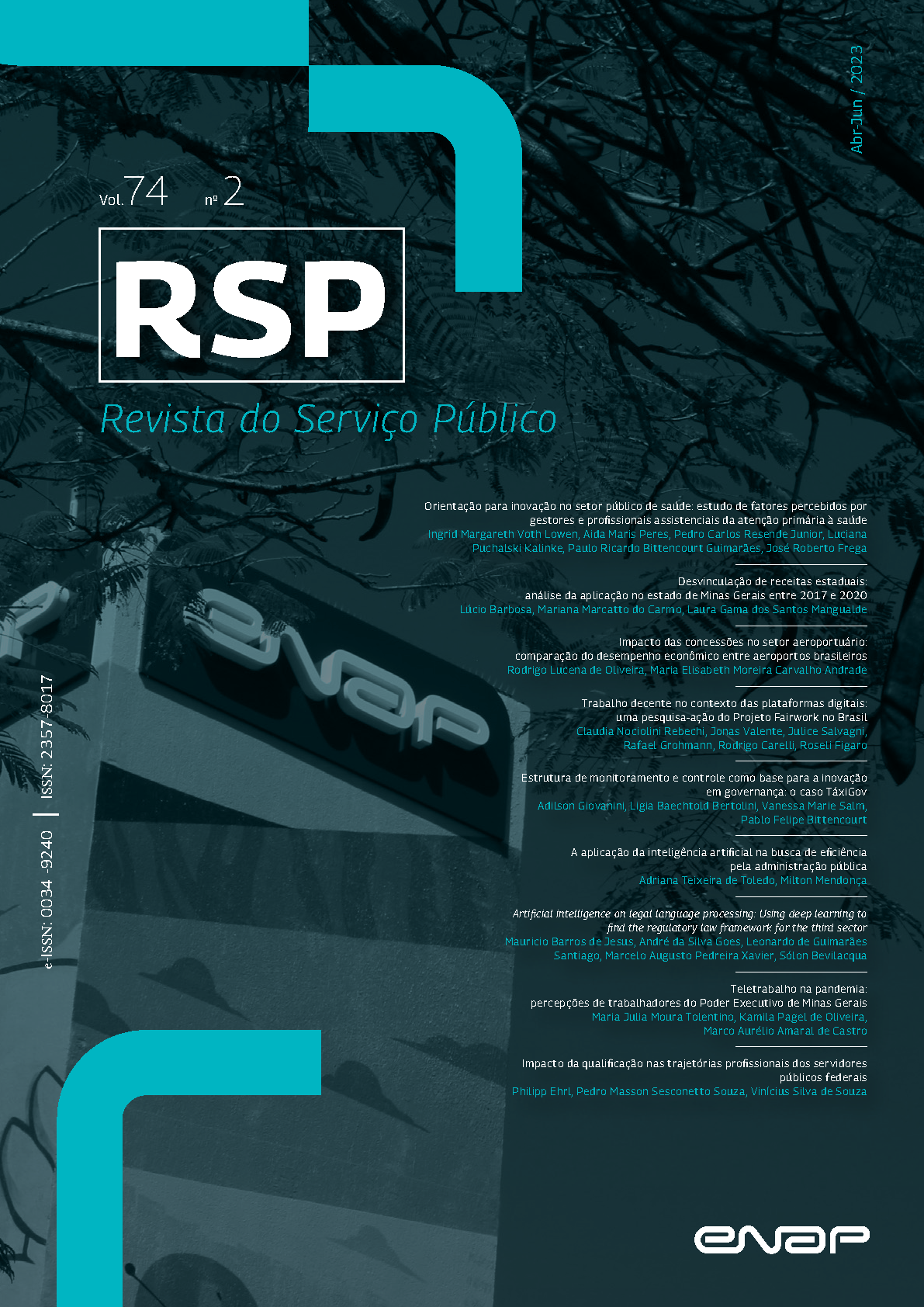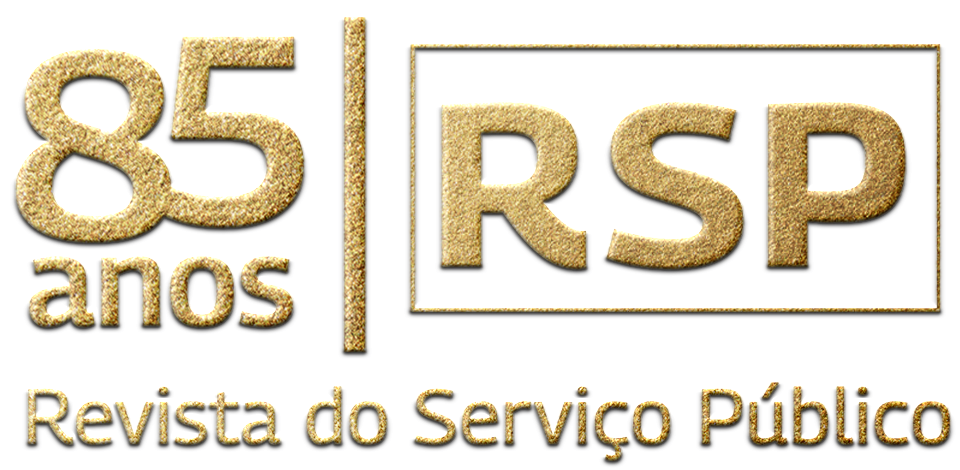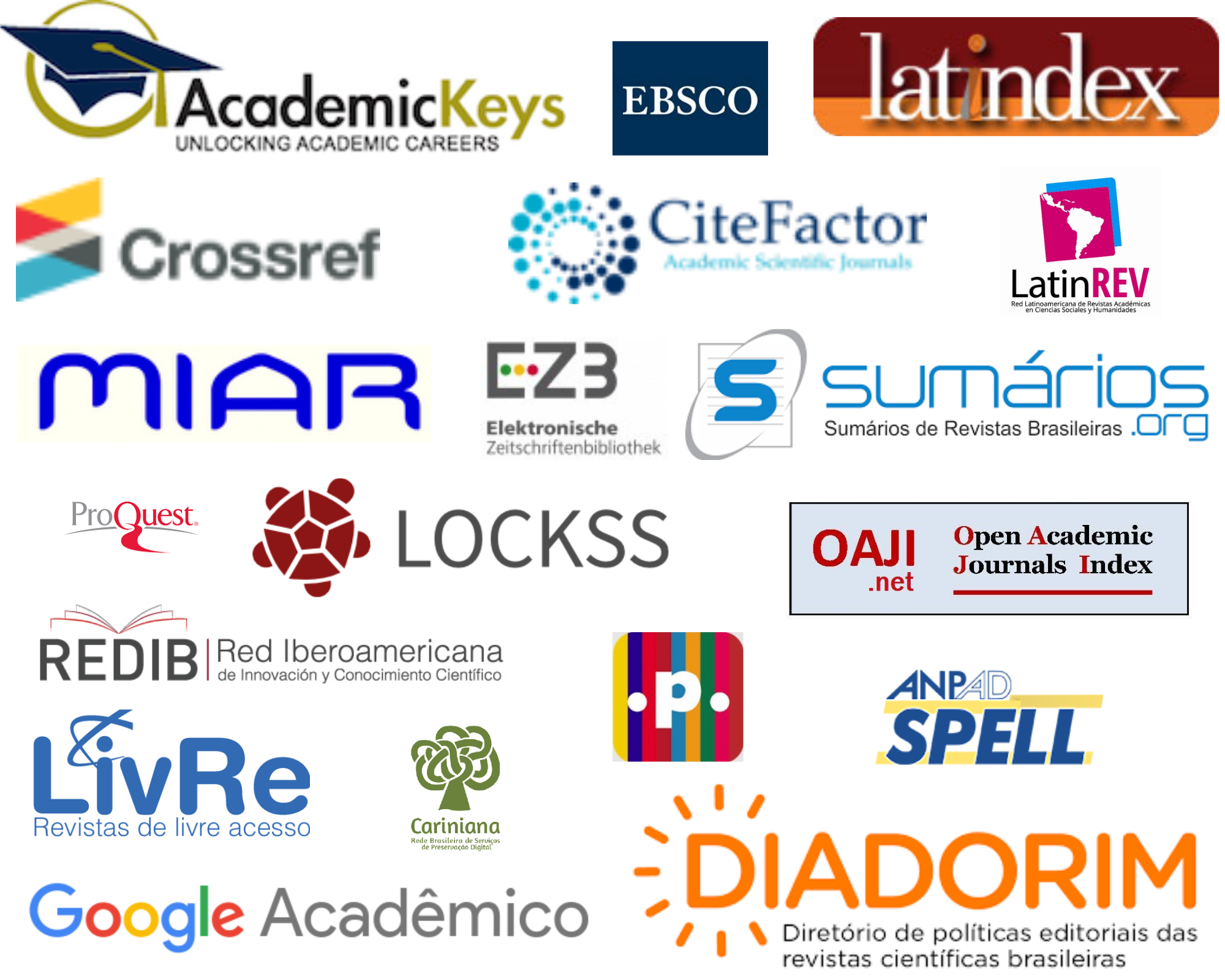Inteligencia Artificial en procesamiento del lenguaje en el derecho: aplicación del deep learning para definir el marco regulatorio del tercer sector
Palabras clave:
tercer sector, regulación, aprendizaje profundo, procesamiento natural del lenguaje, derechoResumen
Este artículo trata sobre la aplicación de algoritmos de inteligencia artificial en el procesamiento del lenguaje jurídico para permitir la identificación de un conjunto completo de normas aplicables a un determinado tema. En este estudio, buscamos delimitar el marco regulatorio que involucra al Tercer Sector, a partir del conjunto de datos sobre el flujo regulatorio brasileño (RegBR). A partir de la investigación bibliográfica se aplicaron técnicas de aprendizaje automático para automatizar la clasificación de cada oración dentro de los actos normativos analizados, permitiendo identificar en qué medida aplica una norma al tema seleccionado. El modelo BERT perfeccionado con extractos de las leyes brasileñas fue muy eficaz y logró un 94 % de precison (F1-Score y AUC). Fue posible encontrar un total de 2.359 reglas esparcidas en 611 actos normativos, retiradas entre 1.330.190 sentencias distribuidas en 51 mil regulaciones, demostrando así cómo las técnicas aplicadas pueden contribuir a la mejora de los temas estudiados.
Descargas
Citas
ABRUCIO, F. L. (2006). Contratualização e organizações sociais: reflexões teóricas e lições da experiência internacional. Debates GV Saúde, 1(10), 24–27.
Advocacia-Geral da União (2018). Manual de Boas Práticas Regulatórias. Brasília: AGU. Retrieved from https://drive.google.com/file/d/1lKjBXT7WQpXWAdM_3xZClsD-BnqvU8-X/view
AMARAL, F. (2016). Aprenda Mineração de Dados: teoria e prática. Alta Books: Rio de Janeiro.
ANSELL, C., & TORFING, J. (2016). Introduction: theories of governance. In: Ansell C., Torfing, J. (editors). Handbook on Theories of Governance. Elgar Online. https://doi.org/10.4337/9781782548508.00008
ARANHA, M. I. (2014). Manual de Direito regulatório: fundamentos de Direito regulatório (2nd ed., Coleford, Gloucestershire, United Kingdom: Laccademia Publishing Limited.
ARANHA, M. I. (2019). Teoria jurídica da regulação: entre escolha pública e captura. RDP - Revista Direito Público - Edição Especial: 15 anos. 16 (2019), 11–37.
BARBOSA, N. B., LIMA, H. de, TRINDADE, A. M. V. da, DIAS, N. V., CASTRO, M. V. de, & SANTOS, C. K. dos. (2015). As Organizações Sociais de Saúde como forma de gestão público-privada em Goiás – o caso HUANA. Revista Do Serviço Público, 66 (1), 121 - 144. https://doi.org/10.21874/rsp.v66i1.686
BERMUDES, W. L., SANTANA, B. T., BRAGA, J. H. O., & SOUZA, P. H. (2016). Tipos de escalas utilizadas em pesquisas e suas aplicações. Revista Vértices, 18 (2), 7-20.
BRASIL (1995). Plano Diretor da Reforma do Aparelho do Estado Cadernos Mare. Brasília: Presidência da República 1995. Retrieved from http://www.biblioteca.presidencia.gov.br/publicacoes-oficiais/catalogo/fhc/plano-diretor-da-reforma-do-aparelho-do-estado-1995.pdf
CHALKIDIS, I., FERGADIOTIS, M., MALAKASIOTIS, P., ALETRAS, N., & ANDROUTSOPOULOS, I. (2020). LEGAL-BERT: The Muppets straight out of Law School. Findings of the Association for Computational Linguistics: EMNLP. https://doi.org/10.48550/arXiv.2010.02559
CRACK, A. M. (2018). The Regulation of International NGOS: Assessing the Effectiveness of the INGO Accountability Charter. Voluntas 29, 419–429. https://doi.org/10.1007/s11266-017-9866-9
DEVLIN, J., CHANG, M., LEE, K., & TOUTANOVA, K. (2019). BERT: Pre-training of deep bidirectional transformers for language understanding. https://doi.org/10.48550/arXiv.1810.04805
DIAS, G., FARIAS, J., COURA, K., DEMO, G., & ATHAYDE, A. (2022). Reflexões sobre a falta de água em algumas regiões brasileiras e a coprodução na gestão pública:: rumo a uma gestão hídrica mais efetiva. Revista do Serviço Público, 73 (1), 32 - 54. Recuperado de https://revista.enap.gov.br/index.php/RSP/article/view/4769
ELLIG, J. (2018). Why and How Independent Agencies Should Conduct Regulatory Impact Analysis. Cornell Journal of Law and Public Policy, 28 (1), 1–34. http://doi.org/10.2139/ssrn.3169413
Escola Nacional de Administração Pública (2022). RegBR. Dados Atualizados em Maio/2022 com foco em normativos regulatórios. Brasília: Enap. Retrieved from https://infogov.enap.gov.br/regbr
FERRI, C., HERNÁNDEZ-ORALLO, J., & MODROIU, R. (2009). An experimental comparison of performance measures for classification. Pattern Recognition Letters, 30 (1), 27-38. https://doi.org/10.1016/j.patrec.2008.08.010
HAHN, R. W. & TETLOCK, P. C. (2008). Has Economic Analysis Improved Regulatory Decisions? Journal of Economic Perspectives, 22 (1), 67–84. https://doi.org/10.1257/jep.22.1.67
HASTIE, T., TIBSHIRANI, R., FRIEDMAN, J., & FRANKLIN, J. (2005). The elements of statistical learning: data mining, inference and prediction. The Mathematical Intelligencer, 27 (2), 83–85. https://doi.org/10.1007/BF02985802
KO, Y., & SEO, J. (2009). Text classification from unlabeled documents with bootstrapping and feature projection techniques. Information Processing & Management, 45 (1), 70-83. https://doi.org/10.1016/j.ipm.2008.07.004
KOOP, C., & LODGE, M. (2017). What is regulation? An interdisciplinary concept analysis. Regulation & Governance, 11 (1), 95–108. https://doi.org/10.1111/rego.12094
LEVI-FAUR, D. (2011). Regulation and Regulatory Governance. In Handbook on the Politics of Regulation. [s.l.] Edward Elgar Publishing, 2011, 3–21. https://doi.org/10.4337/9780857936110.00010
LIU, Y., ZHOU, Y., WEN, S., & TANG, C. (2014). A Strategy on Selecting Performance Metrics for Classifier Evaluation. International Journal of Mobile Computing and Multimedia Communications (IJMCMC), 6(4), 20-35. http://doi.org/10.4018/IJMCMC.2014100102
LUGER, G. F (2013). Inteligência Artificial (6th ed, Daniel Vieira, Trans.) São Paulo: Pearson Education do Brasil.
MCCORMICK, C., & RYAN, N. (2019). BERT Fine-Tuning Tutorial with PyTorch. Retrieved from https://mccormickml.com/2019/07/22/BERT-fine-tuning/
MCMULLIN, C. (2021). Challenging the necessity of New Public Governance: Co-production by third sector organizations under different models of public management. Public Administration, 99 (1), 5–22. https://doi.org/10.1111/padm.12672
MINAEE, S., KALCHBRENNER, N., CAMBRIA, E., NIKZAD, N., CHENAGHLU, M., & GAO, J. (2020). Deep Learning Based Text Classification: A Comprehensive Review. https://doi.org/10.48550/arXiv.2004.03705
MONTANO, M. R., & PIRES, D. D. O. O (2019). Marco Regulatório Do Terceiro Setor: A Oferta Da Educação Infantil No Município De Porto Alegre. Práxis Educacional, 15 (31), 16-17. https://doi.org/10.22481/praxis.v15i31.4656
PHILLIPS, S., & SMITH, S. (2014) A Dawn of Convergence?: Third sector policy regimes in the “Anglo-Saxon” cluster. Public Management Review, 16 (8), 1141–1163. https://doi.org/10.1080/14719037.2014.965272
PHILLIPS, S., & HEBB, T. (2010). Financing the third sector: Introduction. Policy and Society, 29 (3), 181–187. https://doi.org/10.1016/j.polsoc.2010.07.001
SAAB, F., & SILVA, S. A. M. (2021). Evaluating the quality of Regulatory Impact Analysis: a literature review. Revista do Serviço Público, 72(b), 34 - 57. Retrieved from https://revista.enap.gov.br/index.php/RSP/article/view/5875
SANO, H., & ABRUCIO, F. L. (2008). Promessas e resultados da Nova Gestão Pública no Brasil: o caso das organizações sociais de saúde em São Paulo. Revista de Administração de Empresas, 48 (3), 64–80. https://doi.org/10.1590/S0034-75902008000300007
SHAFFER, R., & MAYHEW, S. (2019). Legal Linking: Citation Resolution and Suggestion in Constitutional Law. In Proceedings of the Natural Legal Language Processing Workshop 2019, 39–44. Minneapolis, Minnesota: Association for Computational Linguistics. https://doi.org/10.18653/v1/W19-2205
SHEARER, C. (2000). The CRISP-DM model: the new blueprint for data mining. Journal of data warehousing, 5 (4), 13-22.
SILVA, T. T. S. E., NEVES, C. B. D., JESUS, M. B. D., & MODANEZ, W. (2022). Inteligência artificial e Jurisprudência: delimitação jurisprudencial nas decisões do TCU do conceito aberto de cláusula restritiva ao caráter. Editora Dialética.
SOH, J., LIM, H., & CHAI, I. (2019). Legal Area Classification: A Comparative Study of Text Classifiers on Singapore Supreme Court Judgments. In Proceedings of the Natural Legal Language Processing Workshop 2019, 67–77. Minneapolis, Minnesota. Association for Computational Linguistics. https://doi.org/10.18653/v1/W19-2208
TALESH, S. (2022). Public law and regulatory theory. In Handbook on Theories of Governance. [s.l.] Edward Elgar Publishing. 104–117. https://doi.org/10.4337/9781800371972.00016
VASWANI, A., Shazeer, N., Parmar, N., Uszkoreit, J., Jones, L. Gomez, A., Kaiser, L., & Polosukhin, I. (2017). Attention is all you need. In Advances in Neural Information Processing Systems, 6000–6010. https://doi.org/10.48550/arXiv.1706.03762
VIEIRA, J. P. T. O. (2016). Fragilidades Dos Mecanismos De Controle No Município Do Rio De Janeiro. Rio de Janeiro. FGV EBAPE - Dissertações, Mestrado Profissional em Administração Pública [366]. Retrieved from http://hdl.handle.net/10438/16060
ZHENG, L., GUHA, N., ANDERSON, B., HENDERSON, P., & HO, D. (2021). When does pretraining help? assessing self-supervised learning for law and the CaseHOLD dataset of 53,000+ legal holdings. In Proceedings of the Eighteenth International Conference on Artificial Intelligence and Law (ICAIL '21). Association for Computing Machinery, New York, NY, USA, 159–168. https://doi.org/10.1145/3462757.3466088
Descargas
Publicado
Cómo citar
Número
Sección
Licencia
Derechos de autor 2023 Revista do Serviço Público

Esta obra está bajo una licencia internacional Creative Commons Atribución-NoComercial-CompartirIgual 4.0.
- A RSP adota a licença Creative Commons (CC) do tipo Atribuição – Uso Não-Comercial (BY-NC).
- A licença permite que outros remixem, adaptem e criem obra licenciada, sendo proibido o uso com fins comerciais.
- As novas obras devem fazer referência ao autor nos créditos e não podem ser usadas com fins comerciais, porém não precisam ser licenciadas sob os mesmos termos dessa licença.
- Ao publicar o artigo na RSP, o autor cede e transfere para a ENAP os direitos autorais patrimoniais referentes ao artigo.
- O artigo publicado na RSP não poderá ser divulgado em outro meio sem a devida referência à publicação de origem.
- O autor que tiver o artigo publicado na RSP deverá assinar o Termo de Concessão de Direitos Autorais (em momento oportuno a editoria da Revista entrará em contato com o autor para assinatura do Termo).



